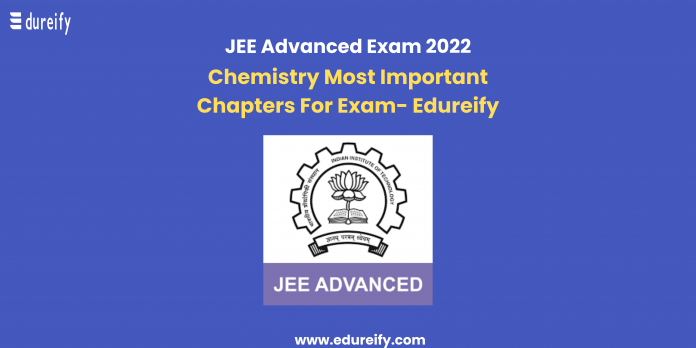The Joint Entrance Exam, JEE is one of the most applied competitive exams in India. Aspirants need to have a strong preparation for JEE Advanced to secure their future in one of the top engineering colleges in India.
Edureify has brought to all the detailed syllabus of the JEE Advanced exam. In this article, we will focus on the Chemistry syllabus for JEE Advanced exam. But before going into the details of the syllabus, the following are some important dates related to the JEE Advanced exam, 2022.
Important Dates
JEE Advanced Paper 1 and 2 (Session 2022)
| Particulars | Dates |
| Application for the Exam (Online) | 7th August-11th August 2022 |
| Last Date of Fee Payment for Registered Candidates | 12th August 2022 |
JEE Advanced AAT (Session 2022)
| Particulars | Dates |
| Application (Online) | 11th-12th September 2022 |
| Exam (Online) | 14th September 2022 |
| Result (Online) | 17th September 2022 |
JEE Advanced Chemistry Syllabus: Important Chapters and Topics
With the important dates taken care of, read on to know the important chapters and topics of Chemistry for JEE Advanced Exam.
Organic Chemistry- Chapters and Topics
| Chapters | Topics |
| Practical of Organic Chemistry | · Detection of Elements (N Elements, S Elements, and Halogens)
· Detection and Identification of the groups: Alcoholic, Phenolic, Aldehyde, Ketone, Amino, and Nitro chemical methods from binary mixtures |
| Amino Acids and Peptides | · Structure and Physical Properties |
| Characteristics Reaction | · Haloarenes: Nucleophilic Substitution in Calories and Substituted Haloarenes
· Amines: Basic of Substituted Anilines and Aliphatic amines, Nitro compounds, reaction with nitro acids, azo coupling reaction of diazonium salts, carbylamine reactions · Carboxylic Acids: Reactions of ester, acid chlorides and amides, ester hydrolysis · Haloform reaction and Grignard addition · Cannizaro reaction · Aldol condensation, Perkin reactions · Aldehydes and Ketones: Oxide reactions, reduction reactions, oxime, and hydrogen reactions · Ethers: Preparation by William’s synthesis · Alkyl Halides: rearrangement reactions of alkyl carbocation, nucleophilic substitution reactions, Grignard reactions · Alcohols: esterification, dehydration and oxidation, reaction with sodium, phosphorus halides, ZnCl2/ concentrated HCL, conversion of alcohols into aldehydes and ketones |
| Reaction of Benzene | · Effects of o⁻, m⁻ and p⁻ groups in the monosubstituted benzene
· Electrophilic substitution reactions like Friedel-Crafts Alkylation and Acylation · Halogenation · Nitration · Sulphonation · Structure of Benzene and automaticity |
| Reactions of Alkanes | · Combustion and Halogenation of alkanes
· Physical properties of alkane like melting point, boiling point and density of alkanes and homologous series · Preparation of Alkanes by Wurtz reaction decarboxylation reactions |
| Use of Polymers | · Natural rubber
· Cellulose · Nylon · Teflon · PVC |
| Carbohydrates | · Mono⁻ and di⁻ saccharides (glucose and sucrose)
· Classification of Carbohydrates · Reduction · Oxidation · Glycoside formation · Hydrolysis of sucrose |
| Phenols | · Reimer-Time reaction
· Kolbe Reactions · Electrophilic substitution reaction · Acidity |
| Reactions of alkenes and alkynes | · Reduction of alkenes and alkynes
· Preparation of alkynes and alkenes by elimination reactions · Electrophilic addition reactions of alkenes with X2, HOX, HX, and H2O (X= Halogen) · Addition reactions of alkynes · Metal acetylides · Reactions of alkenes with KMnO4 and Ozone · Physical properties of alkenes and alkynes · Acidity · Acid-catalyzed hydration of alkenes and alkynes |
| Some other concepts | · Sigma and Pi bonds
· Shapes of Organic Molecules · Hybridisation of Carbon · Structural and geometrical isomerism · IUPAC nomenclature of simple organic compounds · Optical isomerism of compounds containing up to two asymmetric centers · Resonance and hyperconjugation · Newman projections · Keto-enol tautomerism · Inductive and resonance effects on acidity and basicity of organic acids and bases · Polarity and inductive effects in alkyl halides · Formation, structure, and stability of carbocations, carbanions, and free radicals · Reactive intermediates produced during homolytic and heterolytic bond cleavage · Determination of empirical and molecular formulae of simple compounds Hydrogen Bonds |
Inorganic Chemistry- Chapters and Topics
| Chapters | Topics |
| Isolation and Properties of Non-Metals | · Boron
· Nitrogen · Silicon · Phosphorus · Oxygen · Sulphur · Halogens · Properties of allotropes of carbon, phosphorus and sulphur |
| Transition Elements | · Nomenclature of mononuclear coordination compounds, cisterns and ionisation isomerism
· Hybridization and geometries of mononuclear coordination compounds · Definition · General characteristics · Oxidation states and their stabilities, color, calculation of spin-only magnetic moment |
| Ores and Minerals | · Ores and minerals of iron, tin, copper, lead, magnesium, zinc and silver |
| Principles of Qualitative Analysis | · Groups I to V
· Nitrate · Halides (excluding Fluoride) · Sulphate · Sulphide |
| Properties of Different Compounds | · Oxides
· Hydroxides · Peroxides · Bicarbonates · Carbonates · Chlorides · Sulphates · Magnesium · Potassium · Calcium · Halogens: hydrohalic acids, bleaching powder, oxides and oxyacids of chlorine, Xenon fluorides · Oxygen: ozone and hydrogen peroxide · Sulphur: oxides, oxyacids and ammonia · Silicon: silicones, silicates and silicon carbide · Boron: diborane, boric acid and borax · Aluminium: alumina, aluminium chloride and alums · Oxides and chlorides of tin and lead · Potassium permanganate · Silver thiosulphate · Silver oxide · Silver nitrate · Potassium dichromate · Oxides, chlorides and sulphates of Fe2+, Zn2+ and Cu2+ |
| Extractive Metallurgy | · Carbon reduction method
· Self reduction method · Cyanide process |
Physical Chemistry- Chapters and Topics
| Chapters | Topics |
| State of Matters | · Kinetic theory of gases
· Average · Root mean square · Most probable velocities and their relation with Temperature · Law of Partial Pressures · Law of Vapour Pressures · Van der waals equations · Diffusion of gases · Ideal gas equation · Concept of solid and liquid states · Deviation from Ideality |
| Thermodynamics | · First law of Thermodynamics
· Internal energy, work and heat calculations · Reaction of heat, fusion and evaporation · Entropy · Free Energy · Second law of Thermodynamics |
| Electrochemistry | · Electrolyte conductance
· Specific, equivalent and molar conductivity · Kohlrausch’s law · Concentration cells · Faraday’s laws of electrolysis · Nernst equation and its relation to delta (G) · Electrochemical cells · Reactions of cells |
| Solid State | · Close-packed structure of solids
· Packing in fcc, bcc and hcp latticeslonic compounds · Point defects · Seven crystal systems · Classification of solid · Crystalline state |
| Surface Chemistry | · Colloids: Types, general properties and methods of preparation
· Elementary ideas of emulsions, surfactants and micelles · Elementary concepts of adsorption |
| Atomic Structure and Chemical Bonding | · Bohr model
· Quantum numbers · Spectrum of the hydrogen atom · Electronic configurations of elements · Pauli’s exclusion principle and Hund’s rule · Hydrogen Bond · VSEPR model and shapes of molecules · Orbital energy diagrams for homonuclear diatomic species · Uncertainty principles |
| Chemical Equilibrium | · Law of mass actions
· PH and buffer solutions · Acids and bases · Hydrolysis of salts effect concentration, temperature and pressure |
| Kinetics Energy | · Rate constant
· Rates of chemical reactions · First order reactions · Arrhenius equation |
| Solutions | · Raoult’s law elevation of boiling point and depression of freezing point
· Molecular weight determination from lowering of vapor pressure |
| Nuclear Chemistry | · Isotopes and Isobars
· Characteristics of α, β, and γ rays fission and fusion reactions |
| Miscellaneous Topics | · Concept of atoms and molecules
· Dalton’s theory · Chemical formulas · Chemical equations · Oxidation-reduction · Calculations · Displacement reactions · Mole Fractions · Molarity · Molality · Normality |
Here were the important chapters and topics of Chemistry for the upcoming JEE Advanced exam 2022. Edureify makes sure that JEE Advanced aspirants get all the study materials, and can take enough mock tests, quizzes, and more to be well prepared for their upcoming exam. Edureify has particular sections for JEE and Chemistry preparation from which students can avail the notes. For even better practice and study materials download Edureify, the best AI Learning App.
Aspirants can also check the JEE Mains Chemistry Chapter-Wise syllabus of 2022.
Edureify has also prepared an article on the important dates and complete information regarding the JEE Advanced exam 2022. Read the JEE Advanced Dates Revised: Read Complete Information here.
Some FAQs about JEE Advanced Chemistry Syllabus-
1. When is the exam date for JEE Advanced AAT Session 2022?
The JEE Advanced AAT Session 2022 is on the 14th of September 2022.
2. Who is the governing body of the JEE Exam?
The National Test Agency, NTA, is the governing and conducting body of the JEE Advanced Exam 2022.
3. What are the main subjects in the JEE Advanced exam?
Physics, Chemistry and Maths are the main subjects for the JEE Advanced exam.
4. What are the topics from the Isolation and Properties of Non-Metal chapter?
The topics in the Isolation and Properties of Non-Metal Chapter are-
o Boron
o Nitrogen
o Silicon
o Phosphorus
o Oxygen
o Sulphur
o Halogens
o Properties of allotropes of carbon, phosphorus and sulphur
5. From where can I get the study materials for the Chemistry JEE Advanced exam?
Edureify! Edureify has all the important JEE Advanced Chemistry study materials for aspirants to study.
Master Your Coding Skills with BootSelf AI
If you're looking to enhance your coding abilities and upskill in artificial intelligence, look no further than the BootSelf AI app. This innovative platform provides AI-based coding lessons that are tailored to your individual learning pace.
Available on both iOS and Android, you can download the BootSelf AI app and start mastering coding skills today:














